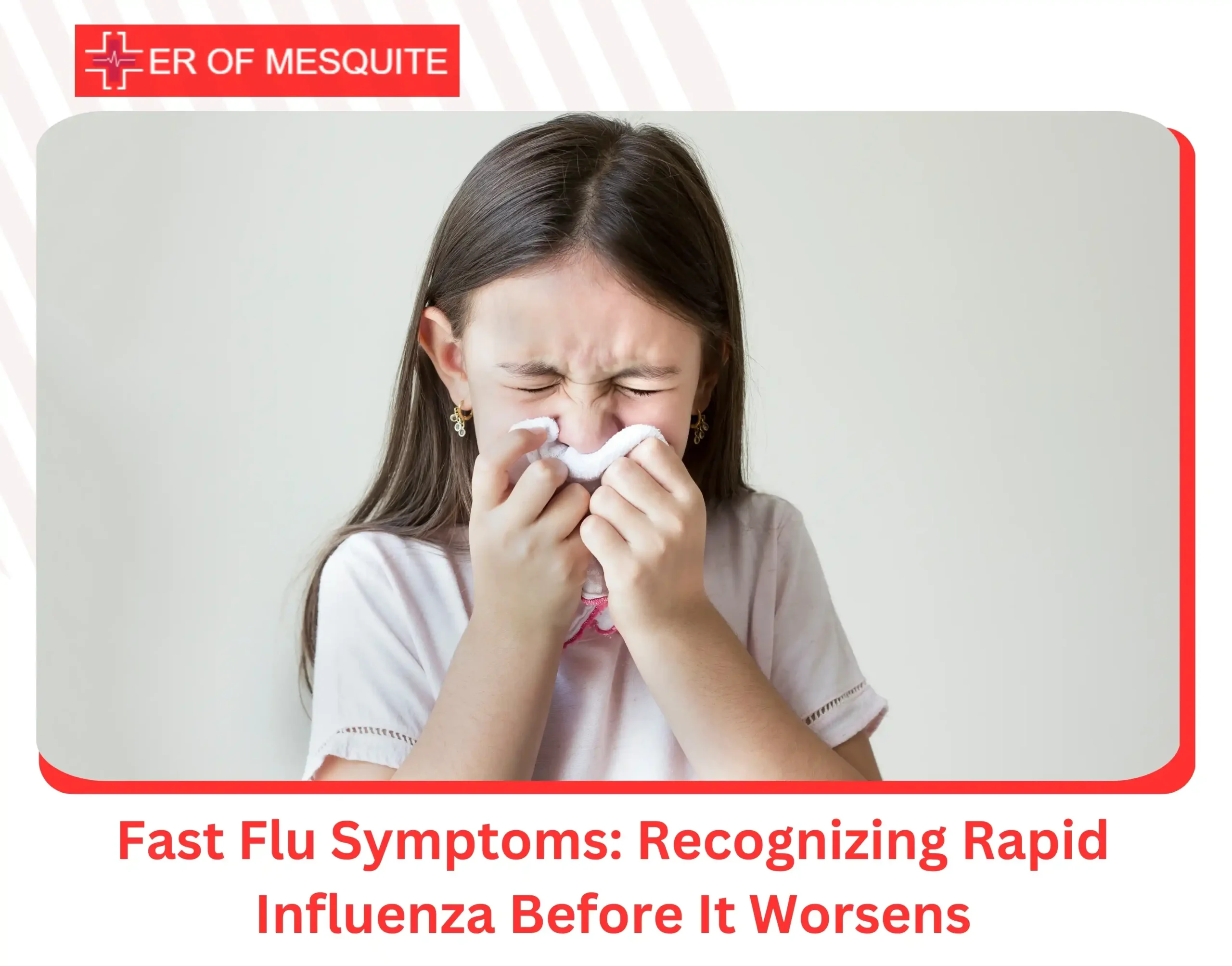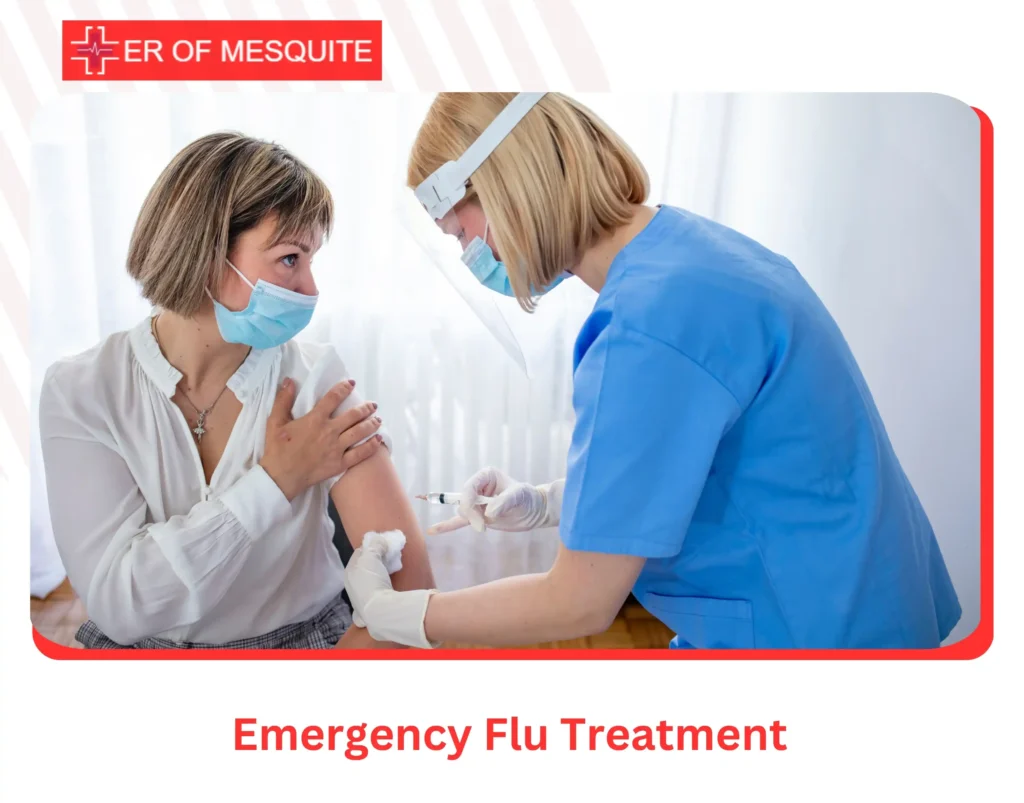The first sign might be a sudden fever or unexpected muscle aches. Within hours, fast flu symptoms can escalate from mild discomfort to severe illness. Unlike regular seasonal flu that develops gradually, fast flu hits suddenly and demands immediate attention.
Knowing these early warning signs can mean the difference between quick recovery and serious complications. Let’s explore fast flu symptoms, when to seek emergency flu treatment, and helpful strategies to prevent illnesses during a flu outbreak.
Understanding Fast Flu: A Rapid-Onset Influenza
“Fast flu” isn’t a medical term doctors use, but it perfectly describes what happens when influenza hits you like a freight train instead of creeping in slowly. This rapid version of the flu can transform you from feeling perfectly fine to severely ill within hours.
What Makes Fast Flu Different?
The main difference is speed. Regular flu typically gives you a day or two of gradually worsening symptoms. Fast flu doesn’t give you that courtesy. You might feel healthy at breakfast but be confined to bed by dinner.
Why does this happen? These aggressive flu viruses multiply incredibly quickly in your respiratory system. Your body responds with an equally rapid immune defense, triggering that sudden crash of symptoms like fever, fatigue, and body ache. This explains why you can feel fine one moment and completely wiped out the next.
Table: Regular Flu vs Fast Flu
| Symptom | Regular Flu | Fast Flu (Rapid-Onset Flu) |
| Onset | Gradual 1-2 days | Sudden within hours |
| Fever | Moderate, gradual | Very high, sudden |
| Body Aches | Moderate to severe | Severe, intense |
| Fatigue | Develops over time | Sudden exhaustion |
| Cough | Dry, can worsen | Immediate, persistent |
| Sore Throat | Common | Common |
| Headache | Sometimes | Very common, severe |
| Duration | 5-7 days | 5-7 days (but harsher start) |
| Contagious | Yes | Yes |
Fast Flu Symptoms
Catching fast flu symptoms early can make all the difference in your recovery. Here’s how you can recognize the early signs of the flu:
1. Sudden high fever (101°F/38.3°C or higher)
Fever in fast flu develops rapidly, often rising within hours rather than gradually over days. This fever is typically higher than what’s seen with common colds and develops much more suddenly.
2. Extreme Fatigue or Weakness
Fast flu brings intense fatigue that feels completely out of proportion. Many patients describe this as a feeling of being “hit by a truck”, an overwhelming exhaustion that makes even simple tasks difficult.
3. Chills and Body Aches
Rapid influenza may also limit movement due to chills and severe body aches. These pains target large muscle groups in your back, legs and arms, often becoming severe enough to interrupt sleep.
4. Headache
Sudden, severe headache is another telltale sign of fast flu, often with light sensitivity. Most people experience this as intense pressure or throbbing pain, typically concentrated behind the eyes or across the forehead.
5. Dry Cough
This typically starts as a dry cough but may produce phlegm as the illness progresses, especially if complications develop.
What makes fast flu symptoms particularly concerning is how quickly they escalate. Unlike a common cold that builds over days, fast flu can transform from barely noticeable to debilitating within just 4-6 hours.
Distinct Symptom Progression of Fast Flu
Fast flu follows a predictable timeline, though it moves much faster than you’d expect:
- Hour 0-2: Early symptoms are usually subtle, such as mild fatigue, a slight sore throat, or a light headache, you might dismiss as stress.
- Hour 2-6: Symptoms intensify quickly, with a sudden fever spike above 101°F accompanied by worsening body aches and extreme tiredness.
- Hour 6-12: This window marks peak severity, featuring intense muscle pain (myalgia), worsening respiratory issues, and a risk of dehydration from persistent high fever.
- Hour 12-24: A critical period where complications like respiratory distress or secondary infections can develop.
This accelerated timeline is particularly dangerous for vulnerable groups including seniors, young children, pregnant women, and anyone with existing health conditions or weakened immunity.
Flu Outbreak Patterns
Flu outbreaks follow seasonal trends, but their patterns can shift due to climate changes and global factors. The severity of flu seasons often correlates with a rise in fast-developing symptoms, making awareness crucial during peak periods.
Flu Season Trends
Flu activity in Texas typically rises in the fall, peaking between December and February, but cases may persist into May. In recent years, unpredictable climate conditions have influenced seasonal flu trends, making them harder to forecast.
Regional differences play a significant role as southern states tend to experience earlier outbreaks, while northern regions often have prolonged flu seasons. Densely populated urban areas see faster transmission due to increased person-to-person interactions.
Global Flu Surveillance
The World Health Organization (WHO) oversees a worldwide flu tracking system (GISRS) to monitor emerging strains and potential pandemic threats. This surveillance allows health officials to react swiftly to highly contagious outbreaks.
Global connectivity plays a key role in flu transmission. International travel and trade can lead to the rapid spread of newly developed strains, and enable influenza to reach different continents within days.
Emergency Flu Treatment
When fast flu symptoms spiral into an emergency, quick action is critical. The ER of Mesquite has set protocols to help patients stabilize and recover before complications get worse.
Emergency Room Protocols
Here’s what usually happens when you come to the ER of Mesquite for serious flu symptoms:
- Comprehensive testing: We immediately run flu tests, strep tests, and other diagnostic evaluations to confirm what we’re dealing with and rule out other conditions.
- Breathing support: If you’re having trouble breathing, you might get oxygen therapy or, in more serious cases, non-invasive ventilation. Sometimes, mechanical ventilation becomes necessary if breathing continues to decline.
- Fever and pain control: High fevers and intense aches are treated with IV medications when pills aren’t enough. This also helps avoid stomach issues that can happen with oral meds.
- Hydration support: Fast flu often causes dehydration because of fever and low fluid intake. IV fluids help quickly restore balance and support vital organs.
- Antiviral medication: Even if you didn’t catch it early, antivirals might still help, especially in severe or complicated cases.
- Treating infections: Fast flu can damage the lungs, making it easier for bacteria to cause pneumonia. If that happens, antibiotics are started right away.
Don’t hesitate to visit our emergency room if you experience breathing difficulty, confusion, severe chest pain, persistent vomiting, or signs of dehydration during a flu illness. These symptoms require immediate attention.
Prevention: Staying Ahead of Flu Outbreak
While we’re always ready to treat flu emergencies, prevention remains your best defense against fast-spreading influenza outbreaks.
Annual Flu Vaccination
The flu vaccine stands as your strongest shield against all influenza strains, including fast-developing variants. Though no vaccine provides 100% protection, vaccinated individuals typically experience:
- Milder symptoms if they do catch the flu
- Shorter illness duration
- Significantly reduced risk of hospitalization
- Lower chance of developing serious complications
CDC recommends:
- Annual vaccination for everyone 6 months and older (with rare exceptions)
- Getting vaccinated by late October, before flu season peaks
- High-dose formulations for adults 65 and older
Even when the vaccine doesn’t perfectly match circulating strains, it provides valuable cross-protection that can mean the difference between a mild illness and a severe one.
Flu Season Tips to Stay Healthy
Beyond vaccination, these practical strategies significantly reduce your infection risk:
- Wash your hands with soap for at least 20 seconds, especially after being in public places.
- Keep distance from people showing respiratory symptoms. Even mild symptoms like sneezing or coughing could be early flu signs.
- Strengthen your immune defenses through adequate sleep (7-9 hours), healthy nutrition, and regular physical activity.
- Wear a mask in crowded indoor settings during local outbreaks.
- Regularly disinfect high-touch surfaces in your home and workspace.
- Improve indoor air quality with HEPA air purifiers, which can reduce airborne viral particles.
Watching flu trends in your area can also help. If you hear about a local flu outbreak, step up precautions right away.
High-Risk Groups: Who Should Be Most Vigilant
Certain populations face elevated risks from fast-progressing flu and should take extra precautions:
- Adults 65 and older: Age-related immune decline affects both immediate and long-term immune responses, making infections more severe and recovery more difficult. Seniors often experience more intense symptoms and longer recovery periods.
- Children under 5: Young children lack immunity to many flu strains and typically experience more severe symptoms during first-time infections. Their smaller airways also make respiratory symptoms particularly dangerous.
- Pregnant women: Pregnancy creates natural changes in the immune system, heart, and lungs that increase vulnerability to severe illness. Flu during pregnancy also poses risks to the developing baby.
- People with chronic conditions: Conditions like asthma, COPD, heart disease, diabetes, and immune disorders either weaken defenses directly or compromise the body systems needed to fight infection effectively.
- Healthcare workers: Regular exposure to infectious patients creates higher infection risk, while the potential to transmit to vulnerable patients makes prevention crucial.
- Residents of long-term care facilities: Close living quarters enable rapid spread, often creating facility-wide outbreaks among already vulnerable populations.
When to Go to the ER for Flu
Fast flu can deteriorate rapidly, often catching patients and families off guard. Seek immediate emergency care if you experience:
- Breathing difficulties: Including shortness of breath, rapid breathing, or feeling like you can’t get enough air
- Severe chest or abdominal pain: May indicate pneumonia or other serious complications
- Confusion or sudden dizziness: Signs that the infection is affecting neurological function
- Severe vomiting: Especially if unable to keep any fluids down
- Symptoms that improve then rapidly worsen: Often indicates a dangerous secondary infection
- Blue discoloration: Of lips, face, or nails (a medical emergency indicating severe oxygen deprivation)
What makes fast flu particularly dangerous is how a seemingly manageable illness can transform into a life-threatening condition within hours. This rapid deterioration is what separates fast flu from typical respiratory infections and why prompt medical evaluation matters.
Taking Action Against Fast Flu
At ER of Mesquite, we provide immediate diagnostic testing, IV hydration therapy, and respiratory support for severe flu cases. Our facility stands ready 24/7 with no waiting times. Just walk in when symptoms become concerning.
Understanding fast flu symptoms gives you a critical advantage. Recognize the early warning signs, prioritize preventive measures like vaccination, and seek prompt treatment when needed. Stay vigilant during flu season to protect yourself and your loved ones from this aggressive illness.
[Visit Our ER for Emergency Flu Treatment]
FAQs About Fast Flu Symptoms
1. Why does fast flu spread more rapidly in urban areas?
Dense populations, public transportation, and shared workspaces create ideal conditions for rapid flu outbreaks. The more people interact in confined spaces, the faster flu transmission occurs, making prevention essential in cities.
2. Does fast flu affect mental clarity?
Yes! The immune response to early signs of the flu can trigger inflammation affecting cognitive function, leading to brain fog, dizziness, and trouble concentrating. Hydration and rest can help mitigate these effects.
3. Could fast flu worsen allergies or asthma?
Absolutely! Flu-related inflammation heightens allergic reactions and can cause severe asthma flare-ups. Those with respiratory conditions should take emergency flu treatment seriously if symptoms worsen.
4. Is fast flu linked to seasonal weather changes?
Sudden temperature drops weaken immune defenses, allowing flu viruses to thrive. Fast flu symptoms tend to appear more frequently when the body struggles to adapt to shifting weather conditions.
5. Can fast flu cause secondary infections?
Yes, a compromised immune system can invite bacterial infections like strep throat or sinus infections. Prompt flu season tips and early interventions reduce this risk.
6. Does fast flu affect sleep patterns?
Fever spikes, congestion, and body aches disrupt sleep, making recovery more challenging. Poor sleep prolongs symptoms and weakens defenses, increasing the likelihood of needing emergency flu treatment.
7. How do antiviral medications help with fast flu?
Antivirals slow viral replication, reducing the severity and duration of illness. However, they work best when taken within the first 48 hours of early signs of the flu, emphasizing the importance of acting quickly.



